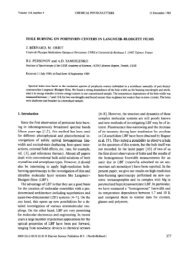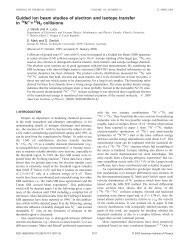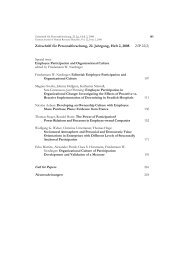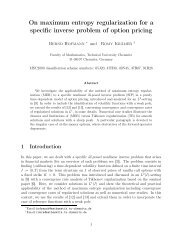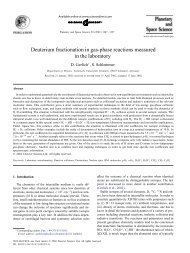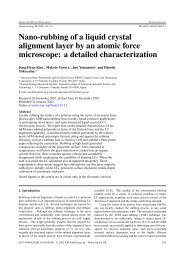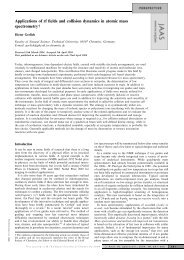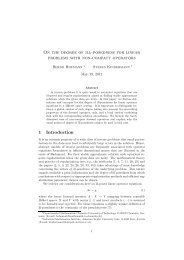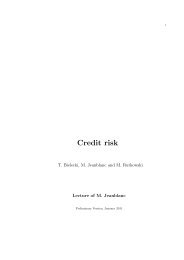On the nature of ill-posedness of an inverse problem arising in option
On the nature of ill-posedness of an inverse problem arising in option
On the nature of ill-posedness of an inverse problem arising in option
Create successful ePaper yourself
Turn your PDF publications into a flip-book with our unique Google optimized e-Paper software.
1334 THe<strong>in</strong><strong>an</strong>dBH<strong>of</strong>m<strong>an</strong>n<br />
∂UBS(X,K,r,t,s)<br />
limt→0 m(t) = ∞,sup (t,s)∈Mc ∂s = ∞ <strong>an</strong>d sup (t,s)∈Mc | ∂ 2UBS(X,K,r,t,s) ∂s 2 | = ∞.<br />
Hence, <strong>the</strong> multiplication operator M def<strong>in</strong>ed by <strong>the</strong> formulae (34) fails to be bounded <strong>in</strong><br />
L2 (0, T ) <strong>in</strong> that case <strong>an</strong>d condition (i) <strong>of</strong> proposition 5.3 c<strong>an</strong>not be verified along <strong>the</strong> l<strong>in</strong>es <strong>of</strong><br />
<strong>the</strong>pro<strong>of</strong> <strong>of</strong> <strong>the</strong>orem 5.4. This s<strong>in</strong>gularity <strong>of</strong> X = K disappears if a variety <strong>of</strong> strike prices K<br />
is used as done <strong>in</strong> <strong>the</strong> sophisticated paper [12] present<strong>in</strong>g a Tikhonov regularization <strong>an</strong>alysis<br />
for <strong>the</strong> more general IP <strong>of</strong> <strong>option</strong> pric<strong>in</strong>g that comb<strong>in</strong>es <strong>the</strong> time- <strong>an</strong>d price-dependent case.<br />
We note, however, that <strong>the</strong> considerations <strong>of</strong> [12] with H 1-solutions a <strong>an</strong>d data u from a<br />
non-Hilberti<strong>an</strong> Sobolev space do not implicate <strong>the</strong> L2-results <strong>of</strong> this section.<br />
6. The discrete approach<strong>an</strong>dsome case studies<br />
F<strong>in</strong>ally, we brieflyaddress <strong>the</strong> situation where we have <strong>option</strong> data uδ j := uδ (t j) approximat<strong>in</strong>g<br />
fair prices u j := u(t j) only for adiscrete set <strong>of</strong> maturities t0 = 0 < t1 < t2 < ··· < tk = T<br />
(for fur<strong>the</strong>r studies see [20]). We assume accord<strong>in</strong>g to formula (18)<br />
u δ 0 = max(X − K, 0), max(X − K e−rtj δ<br />
) 0, due to (6), (9) <strong>an</strong>d (40) all values<br />
Sδ j are uniquely determ<strong>in</strong>ed from (41). The second step conta<strong>in</strong>s a numerical differentiation,<br />
which is regularized accord<strong>in</strong>g to<br />
�J a − S δ � 2 2 + α�L a�2 2 −→ m<strong>in</strong>, subject to a ∈ Rk + ,<br />
with a m<strong>in</strong>imiz<strong>in</strong>g vector aα = (aα 1 , ...,aα k )T ∈ Rk + ,whereα > 0is<strong>the</strong>regularization<br />
parameter, �·�2 denotes <strong>the</strong> Euclide<strong>an</strong> norm, J is a discretization <strong>of</strong> <strong>the</strong> l<strong>in</strong>ear Volterra <strong>in</strong>tegral<br />
operator J <strong>an</strong>d �L a�2 2 expresses <strong>the</strong> usual discretization <strong>of</strong> <strong>the</strong> L2-norm square �a ′′ �2 L2 (0,T ) <strong>of</strong><br />
<strong>the</strong> second derivative <strong>of</strong> <strong>the</strong> function a.<br />
For a case study with computer-generated <strong>option</strong> price data we use <strong>the</strong> values X = 0.6,<br />
K = 0.5, r = 0.05, T = 1, t j = j<br />
k ( j = 1, ...,k = 20) <strong>an</strong>d <strong>the</strong> convex function<br />
σ(t) = (t − 0.5) 2 +0.1 (0 � t � 1).<br />
The exact data u = (u1, ...,uk) T are computed by us<strong>in</strong>g <strong>the</strong> generalized Black–Scholes<br />
formula (1)–(4). Perturbed with a r<strong>an</strong>dom noise vector η = (η1, ...,ηk) T ∈ Rk <strong>the</strong>y yield<br />
noisy data <strong>in</strong> <strong>the</strong> form<br />
u δ j = u j + δ �u�2<br />
η j ( j = 1, ...,k)<br />
�η�2<br />
for a given relative error δ>0. Some results <strong>of</strong> <strong>the</strong> case study are presented by figures 1<br />
<strong>an</strong>d 2 show<strong>in</strong>g on <strong>the</strong> one h<strong>an</strong>d <strong>the</strong> exact solution as a solid curve <strong>an</strong>d on <strong>the</strong> o<strong>the</strong>r h<strong>an</strong>d <strong>the</strong><br />
l<strong>in</strong>early <strong>in</strong>terpolated approximate solution as a dashed curve. Figure 1 <strong>ill</strong>ustrates <strong>the</strong> osc<strong>ill</strong>at<strong>in</strong>g<br />
character <strong>of</strong> <strong>the</strong> unregularized volatility reconstruction, although <strong>the</strong> data error is ra<strong>the</strong>r small<br />
(δ = 0.1%). For <strong>the</strong> same situation a quite good regularized solution is presented <strong>in</strong> figure 2,<br />
where <strong>the</strong> regularization parameter choice is based on H<strong>an</strong>sen’s L-curve criterion (see [19]).<br />
As shown <strong>in</strong> section 3, arbitrage-free <strong>option</strong> data uδ yield <strong>in</strong> a unique <strong>an</strong>d stable m<strong>an</strong>ner<br />
non<strong>in</strong>creas<strong>in</strong>g functions Sδ . If, however, <strong>the</strong> noisy discrete <strong>option</strong> data uδ j are not necessarily<br />
arbitrage free, <strong>the</strong>n for very small δ <strong>the</strong> monotonicity may also be lost for values Sδ j obta<strong>in</strong>ed




